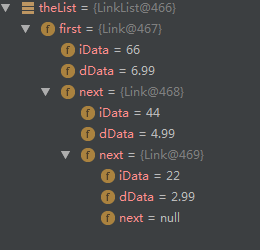/**
* 单链表操作
* Create by Administrator
* 2018/6/14 0014
* 下午 2:05
**/
public class Link {
public int iData;
public double dData;
public Link next;
public Link(int id, double dd) {
this.iData = id;
this.dData = dd;
}
public void displayLink() {
System.out.print("{" + iData + " , " + dData + "} ");
}
}
class LinkList {
private Link first;
public LinkList() {
this.first = null;
}
public boolean isEmpty(){ //判断链表是否为空
return (first == null);
}
public Link find(int key){ //查找指定的对象
Link current = first; //拿到第一个点
while (current.iData != key){ //重第一个开始遍历
if(current.next == null){
return null; //未找到结果
}else {
current = current.next; //获取下一个
}
}
return current; //找到结果
}
public Link delete(int key){ //删除指定对象
Link current = first;
Link previous = first;
while (current.iData != key){
if(current.next == null){
return null;
}else {
previous = current;
current = current.next;
}
}
if(current == first){
first = first.next;
}else {
previous.next = current.next;
}
return current;
}
public void insertFirst(int id,double dd){
Link link = new Link(id, dd);
link.next = first; //储存对象的引用
first = link; //把当前对象赋值给first
}
public Link deleteFrst() { //删除首链表,正好和添加相反
if(!isEmpty()){
Link temp = first;
first = first.next;
return temp;
}
return null;
}
public void displayList(){
System.out.print("List (first-->last): ");
Link current = first;
while(current != null){
current.displayLink();
current = current.next;
}
System.out.println("");
}
public static void main(String[] args) {
LinkList theList = new LinkList();
theList.insertFirst(22,2.99);
theList.insertFirst(44,4.99);
theList.insertFirst(66,6.99);
theList.insertFirst(88,8.99);

theList.displayList();
// while (!theList.isEmpty()){
// Link aLink = theList.deleteFrst();
// System.out.print("Deleted");
// aLink.displayLink();
// System.out.println("");
// }
Link f = theList.find(44);
if(f != null){
System.out.print("find Link: ");
f.displayLink();
System.out.println("");
Link result = theList.delete(f.iData);
if(result != null){
System.out.print("delete success ");
result.displayLink();
}
}
System.out.println("");
theList.displayList();
}
}

